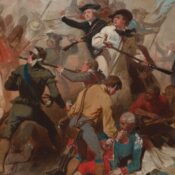President-elect Donald Trump recently announced that one of his day-one executive actions would be to impose 25 percent tariffs on goods from China, Mexico, and Canada. Trump’s views on China and Mexico as threats to the United States have been part of his political platform since his first campaign launch in June 2015, but his inclusion of Canada in this tariff measure (as an attempt to police the border between the two nations) marks a striking addition to the roster. Given that the U.S. is Canada’s largest trading partner, and that oil is Canada’s largest single export to the U.S., the proposed tariff would certainly cause significant upheavals in the economies of and relationship between both nations.
Although U.S.-Canada relations have been largely friendly and peaceful in recent decades, that relationship has experienced a number of tense and even hostile periods over the centuries, fraught moments that reflect key American as well as hemispheric histories. Remembering those historical conflicts offers important contexts for this current moment, and reminds us of the price we always pay when the two nations are opposed, whether it’s over the economy or the border.
Both the American Revolution and the War of 1812 saw influential U.S. military invasions of Canada. The late 1775 invasion of Quebec, undertaken well before the U.S. had even formally declared independence from England, was one of the first extended military conflicts in the unfolding war between the two nations. After some initial successes, including the capture of Montreal in November, the American forces suffered their first significant defeat of the war at the December 31, 1775, Battle of Quebec. Continental Army General Richard Montgomery was killed, more than 400 American soldiers were taken prisoner, and after trying to maintain a blockade for months, the U.S. forces retreated. It was the war’s first major setback for the colonists.

As I traced at length in this prior Considering History column on the War of 1812, the U.S. invasion of Canada in that conflict was even more extended and bloody. That invasion included a number of destructive encounters between U.S. forces and Native American tribes, a third community that has always been a complex and central part of the U.S.-Canada relationship. And the bloodiest and most controversial action of the entire War of 1812 took place in Ontario in May 1813, when U.S. forces burned down not just Fort George but also much of a neighboring civilian town.
No subsequent conflict between the two nations was as violent as those military invasions, but the next century saw a number of border disputes that did come to blows. In the late 1830s, longstanding border tensions between the U.S. state of Maine and the British Canadian colony of New Brunswick, and particularly between lumberjacks in both regions angling for access to prime logging and other resources, escalated into an extended conflict that became known as both the Aroostook War and, far more evocatively, the Pork and Beans War (after the primary foodstuffs consumed by the lumberjacks on both sides). The conflict continued for years and was only finally settled by the international Webster-Ashburton Treaty of 1842.

During those same years, the U.S.-Canada border in the Northwest was similarly the subject of extended and nearly violent dispute. As a corollary to the overarching Manifest Destiny narrative of the U.S. taking over the entire continent, a movement arose for the U.S. to annex the entire contested Pacific Northwest region up to the 54°40’ parallel, near the southern border of what would become the Alaska territory (leading to the slogan “Fifty-Four Forty or Fight!” from those in favor of annexation). After years of both political debate within the U.S. and border hostilities between the two nations, all of which came to be known collectively as “the Oregon Question,” the border was finally settled along the 49th parallel by the 1846 Oregon Treaty.

Although the entire U.S.-Canada border was officially and permanently settled as of these 1840s treaties, there continued to be hostilities around the border in subsequent decades. One of the most striking incidents were the so-called “Fenian Raids” in the years following the Civil War. Civil War U.S. Army veterans, who were also members of the Fenian Brotherhood, an Irish Catholic Republican organization in the U.S., began to raid across the border in 1866 in an effort to harass English Canadians and pressure England to grant independence to Ireland. Targeting British Army forts and customs posts, these raids continued through 1871, in part because the U.S. government, angry at Canadian support for the Confederacy during the war, was slow to take action to oppose the Fenians. When Britain agreed to pay more than $15 million in war reparations with the 1872 Alabama Claims, the conflict died down.

One of the most recent conflicts between the two nations reflects the same kinds of fears over free trade that we’re seeing today. In this case the fears originated on the Canadian side: After Canada’s Liberal government negotiated a Reciprocity Treaty with the U.S. in 1911, the Conservative opposition mounted an extensive fear-mongering campaign claiming that trade between the two nations would threaten Canada’s future. Warning of “selling out” to the U.S. and advocating “No truck or trade with the Yankees,” the Conservatives achieved a significant victory in the 1911 national elections, and created trade and diplomatic gaps between the two nations that (to name only one of many effects) made cooperation between the two nations during World War I more difficult than it should have been.
For much of the last century, the formal relationship between the two nations has been far more friendly and cooperative. As the incoming U.S. president threatens to resume trade and border restrictions, it’s worth remembering the long, fraught history of such conflicts — and the prices both countries have paid for them.
Become a Saturday Evening Post member and enjoy unlimited access. Subscribe now



